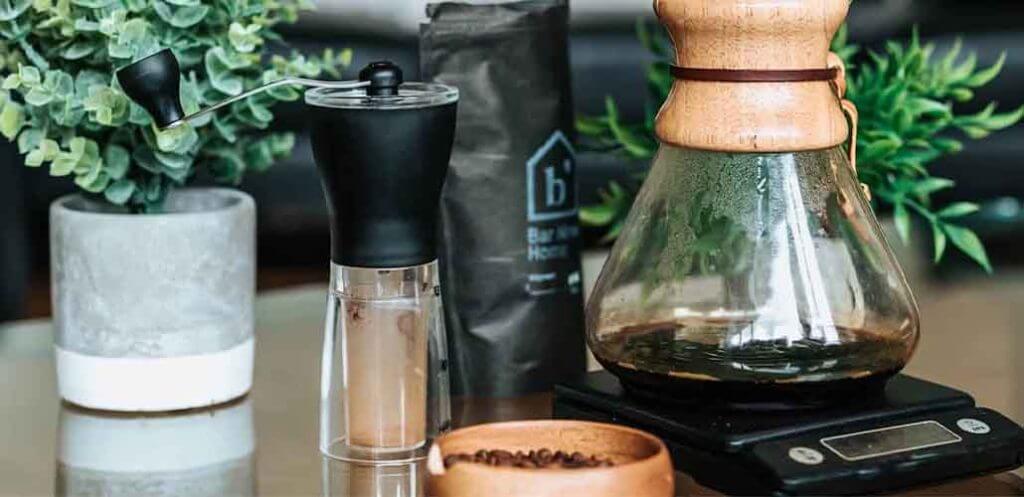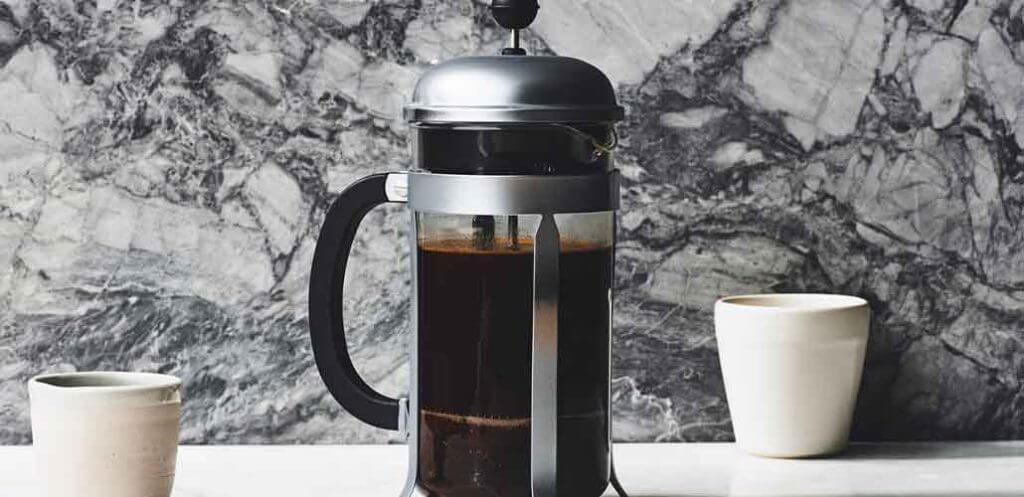Chemex Vs French Press – Which One Do You Choose?
When it comes to manually brewing coffee, two of the most popular methods are the Chemex and French Press. Both offer unique benefits and produce distinct coffee flavors, but which one is best for you? In this article, we will compare Chemex vs the French press, exploring their similarities and differences.
What Is Chemex?
The Chemex is a manual coffee brewing device consisting of a glass container in the shape of an hourglass with a wooden collar and leather tie. Its conical shape has a wide bottom and narrow top, and it uses thicker paper filters folded into a cone, and placed on top.
The process involves adding coffee grounds to the filter and pouring hot water over them, allowing the coffee to brew and drip into the lower carafe. Known for its clean, bright cup with balanced acidity and pronounced flavors, the Chemex remains a favorite among coffee lovers and specialty coffee shops.
History Of A Chemex
Dr. Peter Schlumbohm, a German-American chemist and inventor, created the Chemex coffee maker in 1941. He looked to brew coffee that was both straightforward and flavorful. He developed the Chemex design through trials with various brewing techniques and materials. To this day made from heat-resistant borosilicate glass, ensuring a consistent brewing temperature.
In 1941, Dr. Schlumbohm obtained a patent for the Chemex and started production the following year. The Chemex quickly gained recognition among coffee lovers for its easy-to-use method and ability to brew a clean and bright cup of coffee. Specialty coffee shops embraced it, making it a staple in manual brewing.
Despite the passing of time, the design of the Chemex remains largely the same, continuing to be a favorite among coffee enthusiasts and specialty coffee shops. The Chemex corporation still operates and continues to manufacture coffee makers based on the original design.
How To Make Chemex Coffee?
The key to successful coffee brewing is creating a final product that you enjoy. While different techniques may have advantages, we have included our preferred method using a pour-over brewer below. However, it is important to remember that this is just a starting point and that experimenting with various techniques and adjustments can lead to finding your perfect cup of coffee.
1. Fold The Chemex Filter: into a cone shape and insert it into the Chemex with the three-layer side facing the spout. This placement will minimize the risk of tearing or collapsing and ensure a secure fit.
2. Rinse The Filter With Hot Water: Pour hot water into the Chemex to eliminate any paper flavor and to warm up the brewer, then discard the water
3. Place Freshly Ground Coffee Beans In The Filter: The standard ratio is to use one gram of coffee for every 16 grams of water, but you can alter the proportions to suit your taste preferences.
4. Begin Pouring A Small Amount Of Hot Water: Start by pouring a small amount of hot water (at a temperature between 195 – 200 F) over the coffee grounds, which is known as “blooming.” This process helps to release CO2 from the coffee, enhancing the overall flavor.
5. Pause For 30 Seconds, Then Resume Pouring Hot Water: After a 30-second wait, continue pouring hot water over the coffee grounds in a circular motion. Ensure that all the grounds are evenly saturated and maintain a consistent water level above the coffee.
6. After Pouring The Desired Amount Of Water: Quickly stir the coffee to ensure all the grounds are soaked. Then wait for the coffee to seep through the filter, which typically takes 1-2 minutes.
What Is French Press?

A French press is a method of manually brewing coffee that involves steeping coarse coffee grounds in hot water and then using a plunger to separate the brewed coffee from the grounds. The plunger has a built-in strainer to make this easier for the operator. In addition, it enables you to make coffee by combining the brewing, pressing, and straining processes in one container.
The resulting coffee is known for its strong, rich flavor and the ability to extract more natural oils than other brewing methods. However, the French press typically has more sediment and a slightly gritty texture. Nevertheless, it is a popular method of brewing coffee and is commonly referred to as a Press Pot or Plunger Pot in cafes worldwide.
History Of French Press
The French press was invented in France in the late 19th century. It was initially called a “cafetière à piston” and was patented by Italian designer Attilio Calimani in 1929. The French press coffee maker has evolved, starting as a simple metal or cheesecloth screen attached to a rod, which was pressed into a pot of hot water and coffee grounds.
The French press allows for greater control over the brewing process and produces a strong, full-bodied coffee with a rich flavor. It is also a versatile brewing method, as it can make hot and cold coffee. As a result, the French press has become a staple in homes and cafes and is recognized as a classic coffee brewing device.
How To Make French Press Coffee?
There are countless ways to make a great cup of coffee, but at the end of the day, all we really want is a piping hot, flavorful cup of coffee to kickstart our morning – it’s a simple pleasure.
Luckily, making excellent coffee with a French press is both easy and affordable. If you’re interested in learning how to make a great pot of French press coffee, all you need to know are the essentials. Here’s a guide to get you started.
1. Boil Water: Start by heating water to a temperature of around 200°F (93°C). You can heat the water in a kettle or on a stovetop.
2. Add Coffee To The French Press: Grind fresh coffee beans to a coarse consistency, and add to the French press. You’ll need about 1 to 2 tablespoons of coffee per 8 ounces of water.
3. Pour Hot Water Over The Coffee: saturate all the grounds in the French press, and let it sit for 30 seconds. Then, give it a gentle stir to ensure all the grounds are wet.
4. Let It Steep: Place the lid and plunger on top of the French press but don’t press down yet. Let the coffee steep for 3-4 minutes (or longer for a stronger brew).
5. Slowly Press The Plunger Down: Press down on the plunger with steady force to separate the brewed coffee from the grounds.
6. Pour The Coffee into a cup, mug, or carafe, and enjoy!
Check Out Other Articles
How To Make Traditional Turkish Coffee? - Is It Stronger Than Espresso?
30 Best Online Coffee Subscription Services
How To Make Coffee While Camping - What Are The Methods?
What Is Italian Coffee - How Was It Invented?
12 Different Types Of Coffee - What Are They?
What Are Other Names For French Press?
French press is known by several other names, and here are some of the names and the countries where they are commonly used:
- United Kingdom and Netherlands – cafetière
- United States and Canada – french press or coffee press
- Italy – caffettiera a stantuffo
- Germany – Stempelkanne (“stamp pot”)
- New Zealand, Australia and South Africa – coffee plunger (coffee brewed inside is called “plunger coffee”)
- French – cafetière à piston
Difference Between Chemex And French Press?
Chemex and French press are two popular methods of brewing coffee, and while they may appear similar, they have several differences. Here are some of the key differences between Chemex and French press:
- The Brewing Process: Chemex involves slowly pouring hot water over a paper filter (pour-over method). In contrast, the French press involves steeping coffee grounds in hot water and then separating the brewed coffee with a plunger (immersion method).

- Coffee Taste: French press produces a rich and full-bodied coffee with a stronger aroma due to the mesh filter allowing coffee oils and sediment to pass through, while Chemex produces a clean, bright, and less oily cup of coffee due to the paper filter removing coffee oils.
- Grind Size: The grind size required for each brewing method is different. A coarser grind size is recommended for the French press to avoid sediment passing through the metal filter. In contrast, Chemex requires a medium-coarser grind size to prevent the paper filter from clogging.
- Brew Time: Each method varies depending on the amount of coffee and water used. Chemex takes between 3.5-4.5 minutes, while French press takes slightly longer, typically between 4-5 minutes.
- Convenience: The entire brewing process for Chemex, a manual pour-over method, can take 5-10 minutes and requires more attention and preparation. In contrast, a French press is more straightforward and quicker, requiring only steeping and plunging.
6. Serving Size: The capacity for brewing different amounts of coffee varies between the two methods. Chemex is designed for larger quantities of coffee and can brew up to 4-8 cups at a time. On the other hand, a French press is typically used for smaller amounts, brewing up to 1-2 cups at a time.
7. Design: Chemex has an hourglass-shaped glass carafe, while the French press consists of a cylindrical glass or stainless steel carafe with a plunger and metal mesh filter attached to the lid.
FAQ
Why Is Chemex Coffee Better?
Chemex has an all-glass construction that ensures the freshest taste of the coffee. Additionally, the unique hourglass shape allows for optimal extraction, further enhancing the flavor profile of the final cup. Unlike French press coffee, which can have a thicker and heavier consistency with more sediment and bitterness, Chemex produces a brighter, smoother, and less bitter cup of coffee with a more transparent appearance and is preferred over conventional coffee-making methods.
What Coffee To Water Ratio In A French Press Or Chemex?
Regarding the coffee-to-water ratio, it is generally recommended to use a higher ratio for French Press than Chemex. For Chemex, the Specialty Coffee Association of America (SCAA) recommends the “golden ratio” of 55 grams of coffee per liter of water, which produces a balanced and flavorful cup. However, for the French Press, a higher ratio of 77 grams of coffee per liter of water is recommended to achieve a richer and more full-bodied taste.
Does Coffee Taste Better With A Chemex?
Yes, Chemex-brewed coffee is superior to coffee made with other methods. This is due to the unique combination of the Chemex filter, all-glass construction, and the device’s unique shape. The filters used in Chemex brewing are thicker, which results in a clearer and smoother cup of coffee that tastes better overall.
Final Thoughts
So, which of these delicious brewing methods should you choose? If you prefer a full-bodied, steeped coffee or don’t want to use paper filters, then the French Press may be your preferred method. On the other hand, if you prefer clear, sediment-free coffee or want to maximize the health benefits of your morning cup, Chemex may be a better choice.
You’ll surely enjoy a delicious cup of coffee no matter which brewing method you choose. So, good luck with your decision!





